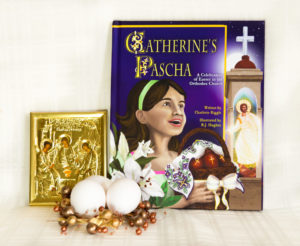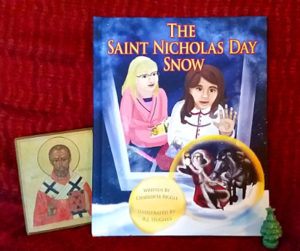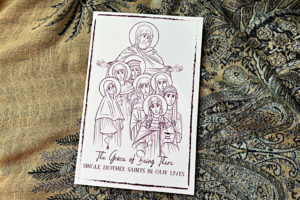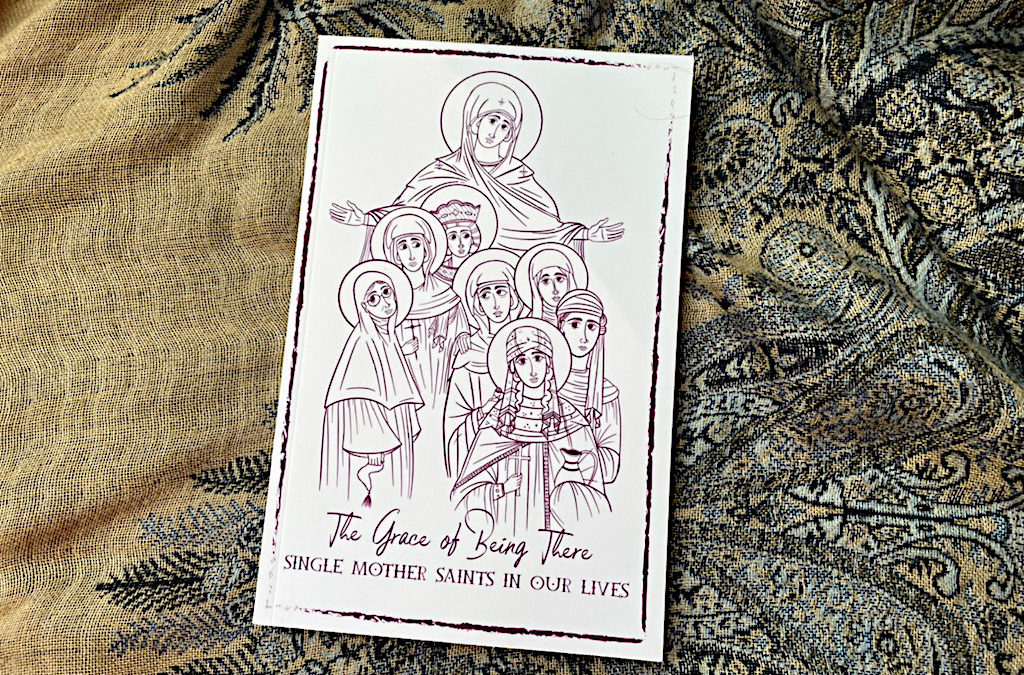What do the saints have to do with being a single mom? Some of the saints were single moms.
I remember being told, years ago, that the Orthodox Church lays out for us two paths to holiness: marriage and monasticism. God, of course, wouldn’t send you to hell if you chose “none of the above.” He would love you anyway.
But, truly, if you wanted to be holy, you needed to get married or join a monastery.
A different path
That’s what I learned, from people who were older and wiser in the faith than I was. And since I was married at the time, that was fine. Until the day I became a single mom with four kids. Then it wasn’t fine any more. Moms with little kids don’t go to monasteries. And, honestly, I didn’t expect that I’d ever marry again. (As it turned out, I was wrong about that, but that’s a different story for a different day.)
As a single mom, I needed a different path to holiness. I needed a model, someone who could show me how to live an Orthodox Christian life as a single mom. I was certainly not the only single mom in the Church. And yet it seemed that the Church had nothing to say to me, to us, about being a single mom. There was no path, no model. We were on our own.
That’s what I thought then. And I was wrong about that, too. Single motherhood is indeed a path to holiness, and the Church is full of saints who can show us what that looks like, saints who were also single moms: St. Helena. St. Photini. Ss. Maria of Paris, Margaret of Cortana, and Monica. The widow of Zarephath. St. Anthousa. And so many, many more.
Creating The Grace of Being There
Last year, Summer Kinard, senior editor at Park End Books, decided to create a book about saints and single motherhood. The book would be called The Grace of Being There.
“When the idea came to me,” Summer said, “I spent a few days praying for all the single mothers–widowed, divorced, never married, or remarried–of my acquaintance. I took time to pray for the memory of my dear grandmother who was a single parent and also like a second mother to me when my mother bore me as an unmarried teenager. Then I asked the saints to help guide me to who I should ask to write about them.”
Responding to the invitations
“When Summer approached me,” said Elissa Bjeletich Davis, “I was really busy, and because of my divorce, I was in a place where I wasn’t writing much. I couldn’t imagine taking on a project at that moment, but when she said she wanted to assign me St. Helena, I stopped in my tracks. Helena had been bubbling up to me all week, bumping into me and showing herself, and I just knew I was supposed to write this. It didn’t feel like a choice: I understood that this is what I was supposed to do.”
“For myself,” said Sandra Anderson, “I was shocked when Summer contacted me to participate in this project. I like to say I’m a talker not a writer, as my only experience with writing has been a monthly article in ministry in our parish newsletter.” Even so, Summer persuaded Sandra to write about St. Photini.
Summer invited Angela Doll to write about a different martyr, Mother Maria of Paris. Angela is a poet, a fiction writer, and an essayist. “I don’t usually write about saints,” she said, “but I do often write with them looking over my shoulder or watching from the wall across the room. It’s comforting. It feels like holy co-working in these Covid times.”
Unlike Angela, I do write about saints. My blog is full of stories about saints that I have found interesting or intriguing. I grew up Presbyterian, and Presbyterians don’t “do” saints. In fact, I thought I would never be able to become Orthodox, because I didn’t think I’d ever be able to venerate the saints. I was wrong again. Somehow, I have fallen in love with the saints, and their presence and their lives have become a real joy. So when Summer asked me to write about the widow of Zarephath, I happily agreed. My only concern was whether I’d be able to learn enough about her to write a compelling story. I needed to get to know her.
Getting to know a saint
“When I was asked to write about single parenting and St Maria of Paris,” Angela said, “I knew her only a little. I placed her icon close to me. ‘We’re in this together,’ I said aloud. I didn’t exactly ask for help outright but she lent her steady support through her gaze anyway and that was enough.”
I didn’t have an icon of the widow of Zarephath to help me get closer to her. In fact, I don’t believe that I’ve ever seen an icon of her. I had to get to know her by reading about her.
It turns out that Angela got to know St. Maria the same way. She explained, “I spent the first day just getting to know her better by reading about her life and reading her words. The more I read the closer we became. She stopped being a name in a book or a quote on a page but became, instead, a friend who knew me, who saw inside of me and lent a shoulder for me. What we wrote together for The Grace of Being There broke my heart open at a time when it needed the opening and those words, while difficult to write, were vital to healing. Glory to God for all things.”
Our children’s stories
One of the difficulties that we all faced was the fact that our stories of single motherhood weren’t just about us. Other people were part of our stories. Especially our children.
This was a major concern for Sandra. “I prayed about it and consulted my dear friend on whether to try this or not,” she explained. “I stepped out of my box, but not without asking my daughter for permission to share what I knew would be difficult truths. I always tell my truths, but putting them in print is another story. You see, my truth is also revealing a bit about my daughter’s truth as well, and I wasn’t sure she would be comfortable with people having an insight into her difficult childhood. God is good and I wrote my chapter with her encouragement. We continue to heal together.”
And then there’s the chapter about St. Margaret of Cortona. Summer said that, after she lined up the first six stories from the book, she realized that she still needed a Catholic voice. “This book needed to be intersectional for Catholic and Orthodox and Byzantine Catholic and Western Rite women, too,” she said. “Thankfully I had connected with Carrie Chuff, a deeply honest writer with a strong voice, when I was putting together Darkness is as Light, to which she contributed. It seemed perfect to have an essay from someone who had been reared by a single mother and had dedicated years of her life to service under the patronage of the Catholic patroness of single mothers.”
Iconography and compassion
Each story in The Grace of Being There starts with a drawing of the saint for that chapter. “For the artwork, I wanted someone who had iconography in their blood and compassion their heart,” said Summer. “I saw that combination in the sticker artwork from Art of Marza, Mary Sarchizian. Her ability to convey deep feeling in a few lines is remarkable, and I feel the love of Christ and the Holy Mother when I see her illustrations for this book. At Park End Books, we see art as telling its own story, not merely repeating what’s in a book. Readers are going to be enriched spiritually from this artwork, which captures the joy and sorrow of women saints with elegance and grace.”
“When Summer asked me to do the illustrations for The Grace of Being There,” Mary said, “I was shocked. I had never illustrated a book before, nor did I think I was good enough. But someone saw value in me and met me where I was, the way God does.”
Me, I was shocked that Mary was shocked. I love her art, and it seems to me to be a perfect fit for the book. You can feel her love for the saints, and their love for us, in every line of her illustrations.
“I was so happy to work on The Grace of Being There,” Mary said, “and to learn through the saints how God works through and meets every mother where they are, especially the mothers we don’t give enough credit to.
“I think single mothers can often be made to feel like they aren’t good enough or far from the ideal, so I am thankful that this book offers encouragement from the saints. I think many folks in the Church can get caught up with ideals. The Grace of Being There brings the lives of the saints and our own lives closer together over the divide we often create in our minds between us and the very human, messy, and imperfect saints we see adorned in gold leaf.”
The writers respond to The Grace of Being There
All of us who wrote for The Grace of Being There knew what we’d written, but we didn’t get to see the other stories until early February. When Summer sent us all a not-laid-out, uncorrected draft of the book, our book, I don’t think I was the only one who had tears in her eyes.
“After reading all the chapters I am blown away by the beauty and truths all of us were able to share,” said Sandra, “and my prayer this book will bring comfort and hope to other women who have shared in the struggle of raising a family on their own.”
“I love how this book has turned out,” said Elissa. “I really enjoyed researching and writing my part, but reading everyone else’s chapters has been amazing. It’s such a good book, and these essays make me feel so connected and seen. I’m so glad this book is going to be out in the world, and I’m in awe of Summer who is just always making wonderful things happen.”
The other women who wrote essays for The Grace of Being There are Kristina Roth, who wrote about St. Monica, and Elizabeth Gatling, who tells the story of St. Anthousa, and the importance of aunties, through the framework of a K-drama.
Read More
When names matter more than money: Sometimes, the greatest kindness you can do for a person is to call them by their name.
In this family, we don’t judge: The lives of the saints are full of stories that teach us not to judge others.
A table where strangers are welcome: It all started on the day that I found a leg in Mrs. Monagan’s closet. A human leg. Her husband’s leg.

Books by Charlotte Riggle

This holiday classic shares the joy of Pascha through the eyes of a child. Find it on Amazon or Bookshop.org.
![]()

This delightful story is filled with friendship, prayer, sibling squabbles, a godparent’s story of St. Nicholas, and snow. Lots and lots of snow. Find it on Amazon or Bookshop.org.
![]()

In this collection of essays, women who are, or have been, single mothers share stories of their relationships with saints who were also single mothers. Charlotte’s story of the widow of Zarephath highlights the virtue of philoxenia. Find it on Amazon or Park End Books.




